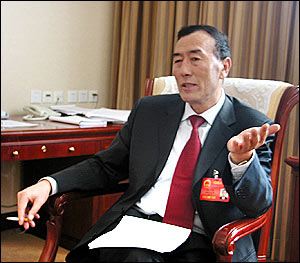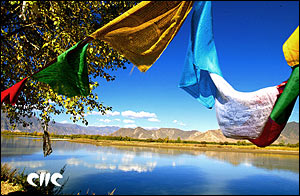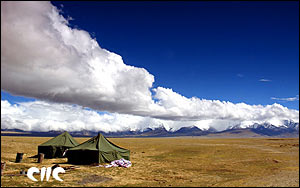Qiangba Puncog, chairman of Tibet Autonomous Region, told China.org.cn that the region is determined to accelerate economic development while paying adequate attention to environmental protection.
He was speaking at the sidelines of the Third Session of the 10th National People’s Congress in Beijing.
Like other parts of China, Tibet witnessed rapid economic growth in 2004 with gross domestic product (GDP) reaching 21.2 billion yuan (US$2.56 billion), a historic high. But Puncog pointed out that the figure is still small when compared to the rest of the country.
He said that about 80 percent of GDP growth was from agriculture and animal husbandry, and that it was essential for Tibet to develop “distinctive farm produce” like qingke (highland barley), kale and other green vegetables.
In the meantime, Tibet is expanding agricultural industrialization, including qingke brewing, oil extraction and use of animal by-products, according to Puncog.
Talking about Tibet’s industrial development, he said they have already set five pillar industries including tourism, traditional Tibetan medicine, minerals, wood and traditional craftworks. He said that in the coming years, development of these should be grounded on protection of the environment.

The region’s unique landscape and culture attracts tourists worldwide. In 2003, it received 900,000 visits, jumping to 1.2 million last year and earning tremendous revenue.
Some 102,000 kilometers of road has been built, which is far below demand. Last year, over 16.6 billion yuan (US$2 billion) was invested in building infrastructure, the majority of which came from central government under its “West China Development Strategy.”
The high-altitude Qinghai-Tibet railway project is being built with ecological safeguards in mind, like carefully removing and reinstating surface vegetation and building viaducts for the passage of wild animals.
The central government provided a special fund of nearly 2 billion yuan (US$242 million), about eight percent of total expenses, to environmental protection along the railway, and the five-year project was extended one year in order for related scheme evaluation, Puncog said.
The construction of the railway project has reduced its impact on the environment as much as possible, providing a model for other development work in Tibet. Puncog said that local government decided to take equivalent measures along the Qinghai-Tibet highway.

The railway project, which is due to begin trial operations in July 2006, will promote exchange and communication between Tibet and other parts of the country, and should attract more tourists from both China and overseas. Puncog said that local government had already stepped up controlling numbers of visitors to vulnerable areas such as the Potala Palace.
It is also devoted to solving energy problems, another bottleneck of economic development, said Puncog.
Hydropower, geothermal and solar energy are the main sources, but current installed capacity, about 490,000 kw/h, cannot meet demand. On the other hand, nearly one million people in Tibet can’t use electricity for lighting.
He said that the region gave priority to the development of renewable energies, which are abundant in Tibet and suit its dispersed population distribution.
Tibet also has abundant mineral reserves, but little is extracted due to insufficient transportation and the need to protect the local ecology.
“We shouldn’t either just let them be or tap them freely,” said Puncog, adding that the size and nature of reserves should be ascertained first.

(China.org.cn by staff reporter Tang Fuchun March 9, 2005)

